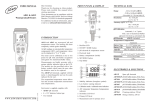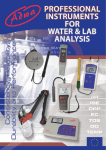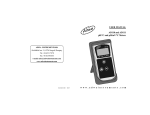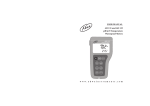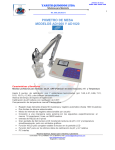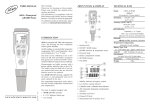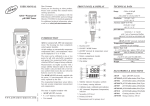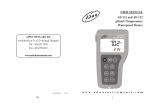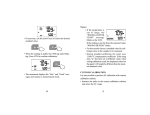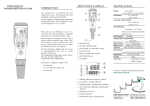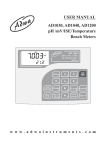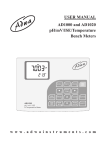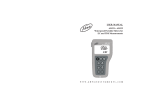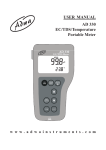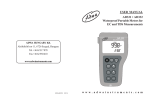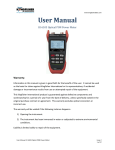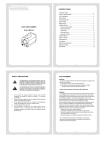Download USER MANUAL AD11 & AD12 Waterproof pH Testers
Transcript
Dear Customer, Thank you for choosing an Adwa product. Please read carefully this manual before starting operations. These instruments are in compliance with the EMC Directive 89/336/EEC and Low Voltage Directive 73/23/EEC for electrical equipments. For additional technical information, please e-mail us at [email protected]. USER MANUAL AD11 & AD12 Waterproof pH Testers FRONT PANEL & DISPLAY Range INTRODUCTION AD11 and AD12 are waterproof pH and temperature testers. The housing has been completely sealed against humidity. All pH readings are automatically temperature compensated (ATC), and temperature values can be displayed in °C or °F units. The meter can be calibrated at one or two points for pH with auto-buffer recognition and against five memorized buffer values. 1. Dual line LCD 2. ON/OFF/ MODE button 3. pH electrode & temperature sensor 4. Electrode body 5. Battery compartment (inside) 6. SET/HOLD button 7. Clip holder Measurements are highly accurate with a unique stability indicator right on the LCD. The models are also provided with a low battery symbol which warns the user when the batteries need to be replaced. w w w. a d w a i n s t r u m e n t s . c o m ISTAD12 04/10 The AD11P pH electrode, supplied with the meter, is interchangeable and can be easily replaced by the user. The encapsulated temperature sensor allows fast and accurate temperature measurement and compensation. Each meter is supplied complete with: • AD11P pH electrode • 4 x 1.5V batteries, button type • User manual TECHNICAL DATA -2.0 to 16.0 pH (AD11) -2.00 to 16.00 pH (AD12) -5.0 to 60.0°C / 23.0 to 140.0°F Resolution 0.1 / 0.01 pH 0.1°C / 0.1°F Accuracy (@20°C/68°F) ±0.1 / ±0.01 pH ±0.5°C / ±1°F pH Calibration Automatic, 1 or 2 point with 2 sets of memorized buffers (pH 4.01/7.01/10.01 or 4.01/6.86/9.18) pH Electrode AD11P (included) Temperature Compensation Automatic Battery Type 4 x 1.5V button type Battery Life Approx. 300 h of use Auto-off After 8 minutes of non-use Environment -5 to 50°C (23 to122°F); RH 100% Dimensions 175.5 x 39 x 23 mm Weight 100 g ELECTRODES & SOLUTIONS 1. Stability indicator (hourglass symbol) 2. Low battery warning indicator 3. Calibration mode / calibrated meter indication 4. ATC (Automatic Temperature Compensation) indicator 5. Secondary LCD level 6. Primary LCD level 7. Measurement unit for primary level AD11P A70004P Spare pH electrode pH 4.01 buffer, 20 ml, 25 pcs A7004M A70007P A7007M pH 4.01 buffer, 230 ml bottle pH 7.01 buffer, 20 ml, 25 pcs pH 7.01 buffer, 230 ml bottle A70010P A7010M A7061M pH 10.01 buffer, 20 ml, 25 pcs pH 10.01 buffer, 230 ml bottle Electrode cleaning solution, 230 ml Storage solution, 230 ml A70300M OPERATIONAL GUIDE Turn the meter on • Press and hold the ON/OFF/MODE button until the LCD lights up. All the used segments will be visible for one second (or as long as the button is pressed). Freeze the display • While in measurement mode, press the SET/HOLD button. The reading will be frozen on the LCD. Press any button to return to normal mode. Turn the meter off • While in measurement mode, press the ON/OFF/MODE button. OFF will appear on the secondary display. Release the button. Note: If measurements are taken in different samples successively, rinse the probe thoroughly to eliminate cross-contamination. After cleaning, rinse the probe with some of the sample to be measured. pH MEASUREMENT & CALIBRATION Taking Measurement • Submerge the electrode in the solution to be tested while stirring it gently. • Measurements should be taken when the stability indicator (hourglass) disappears. • The pH value automatically compensated for temperature is shown on the primary LCD level while the secondary one shows the sample temperature. Note: Before taking any pH measurement, make sure the meter has been calibrated (CAL tag is displayed). pH Calibration For better accuracy, frequent calibration of the instrument is recommended. In addition, the instrument must be recalibrated whenever: a) The pH electrode is replaced. b) After testing aggressive chemicals. c) Where high accuracy is required. d) At least once a month. Calibration Procedure • From normal measuring mode, press and hold the ON/OFF/MODE button until OFF on the secondary LCD is replaced by CAL. • Release the button. The LCD enters the calibration mode displaying “pH 7.01 USE” (or “pH 6.86 USE” if the NIST buffer set was selected). • The meter automatically recognizes buffers: if a valid buffer is detected then its value is shown on the primary display and REC appears on the secondary LCD level. If no valid buffer is detected, the meter keeps the USE indication active for 12 seconds, followed by WRNG, indicating the buffer being measured is not a valid calibration value. Single-Point Calibration • For a single-point calibration with buffers pH 4.01, 9.18 or 10.01, the meter automatically accepts the calibration when the reading is stable. The accepted buffer is displayed together with the message “OK 1” for one second, then the meter automatically returns to the normal measuring mode. • If a single-point calibration with buffer pH 7.01 (or pH 6.86) is desired, then after the calibration point has been accepted, press the ON/OFF/MODE button to return to normal mode. The meter shows “7.01” (or“6.86”) and “OK 1” for one second, then it automatically returns to the normal mode. Note: For better accuracy, it is recommended to perform a 2-point calibration. Two-Point Calibration • For a two-point calibration, place the electrode in pH 7.01 (or pH 6.86) buffer. After the first calibration point has been accepted, the “pH 4.01 USE” message appears. The message is held for 12 seconds, unless a valid buffer is recognized. If no valid buffer is recognized, then the WRNG message is shown. If a valid buffer (pH 4.01, 10.01, or 9.18) is detected, then the meter completes the calibration procedure. The LCD shows the accepted value with the “OK 2” message, and then the meter returns to the normal mode. Note: When the calibration procedure is completed, the CAL tag is turned on. To quit calibration & reset to default values • After entering the calibration mode and before the first point is accepted, you can quit the procedure and return to the last calibration data by pressing the ON/OFF/ MODE button. The secondary LCD displays “ESC”for one second and then the meter returns to the normal measuring mode. • To reset to the default calibration values, press SET/HOLD after entering the calibration mode and before the first point is accepted. The secondary LCD displays “CLR” for one second, the meter resets to the default calibration and the CAL tag disappears. ELECTRODE MAINTENANCE When not in use, rinse the electrode with water and store it with a few drops of A70300M storage solution in the protective cap. NEVER STORE THE ELECTRODE IN DISTILLED OR DEIONIZED WATER! • If the electrode has been left dry, soak the tip in storage solution for at least one hour to reactivate it. • To prolong the electrode life, it is recommended to clean it monthly by immersing the tip in A7061M general cleaning solution for 30 minutes. Afterwards, rinse it thoroughly with tap water and recalibrate the meter. • The electrode can be easily replaced by unscrewing the body as shown below. SETUP Setup mode allows the selection of temperature unit and pH buffer set. To enter the setup mode, press the ON/OFF/ MODE button until CAL on the secondary display is replaced by TEMP and the current temperature unit (e.g. TEMP °C). Then: For °C/°F selection: • Use the SET/HOLD button. After the temperature unit has been selected, press the ON/OFF/MODE button to enter the buffer set selection mode. • Press the ON/OFF/MODE button again to return to the normal measuring mode. To change the calibration buffer set: • After setting the temperature unit, the meter will show the current buffer set: “pH 7.01 BUFF” (for 4.01/7.01/10.01) or “pH 6.86 BUFF” (for NIST 4.01/6.86/*9.18). • Change the set with the SET/HOLD button, then press ON/OFF/MODE to return to the normal measurement mode. BATTERY REPLACEMENT When the batteries become weak, the battery symbol on the LCD lights up to indicate a low battery condition. Batteries should be replaced soon. To change the batteries, unscrew and release the electrode body. Take out the battery compartment and carefully replace all four batteries while paying attention to their polarity. Reattach and tighten the electrode body properly to ensure a watertight seal.



